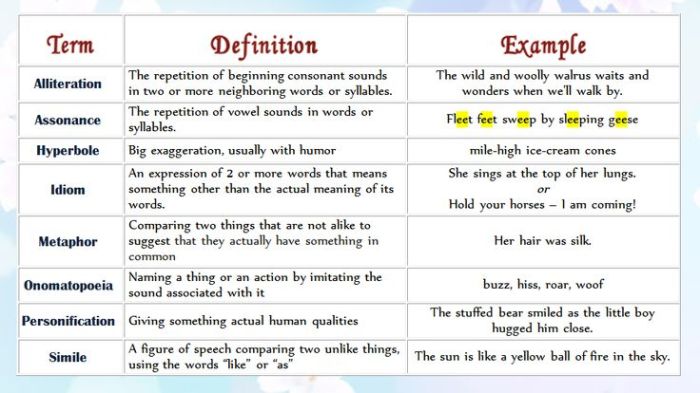Figurative language for 6th graders is a captivating journey into the realm of literary devices that breathe life into words, transforming everyday communication into a vibrant tapestry of expression. This guide delves into the intricacies of similes, metaphors, personification, hyperbole, and onomatopoeia, empowering young minds to harness the transformative power of language.
As we explore the nuances of figurative language, students will discover its profound impact on writing, unlocking their potential to craft vivid imagery, convey complex emotions, and captivate audiences with their eloquence.
Introduction to Figurative Language for 6th Graders
Figurative language is a powerful tool that writers and speakers use to create vivid images, express emotions, and make their writing and speech more engaging. It is a way of using words in a non-literal way to create a deeper meaning or effect.
There are many different types of figurative language, each with its own unique purpose and effect. Some of the most common types of figurative language include:
- Similes
- Metaphors
- Personification
- Hyperbole
- Onomatopoeia
Figurative language is an essential part of writing and communication. It helps writers and speakers to create more vivid, engaging, and memorable content.
Simile
A simile is a figure of speech that compares two things using the words “like” or “as.” Similes are often used to create vivid images or to make a point more memorable.
For example, the sentence “The sky was as blue as the ocean” is a simile that compares the color of the sky to the color of the ocean.
Metaphor
A metaphor is a figure of speech that makes a direct comparison between two things without using the words “like” or “as.” Metaphors are often used to create a more vivid image or to make a point more powerful.
For example, the sentence “Life is a journey” is a metaphor that compares life to a journey.
Personification
Personification is a figure of speech that gives human qualities to non-human things. Personification is often used to make writing more vivid or to create a more personal connection with the reader.
For example, the sentence “The wind whispered through the trees” is a personification that gives the wind human qualities.
Hyperbole, Figurative language for 6th graders
Hyperbole is a figure of speech that uses exaggeration to create emphasis or humor. Hyperboles are often used to make a point more memorable or to create a more vivid image.
For example, the sentence “I’m so hungry I could eat a horse” is a hyperbole that exaggerates the speaker’s hunger.
Onomatopoeia
Onomatopoeia is a figure of speech that uses words that imitate sounds. Onomatopoeia is often used to create a more vivid image or to make a point more memorable.
For example, the word “buzz” is an onomatopoeia that imitates the sound of a bee.
Using Figurative Language Effectively: Figurative Language For 6th Graders
Figurative language can be a powerful tool, but it is important to use it effectively. Here are a few tips for using figurative language effectively:
- Use figurative language sparingly. Too much figurative language can be confusing and distracting.
- Choose the right type of figurative language for your purpose. Different types of figurative language have different effects, so choose the one that will best help you achieve your desired effect.
- Use figurative language in moderation. A little bit of figurative language can go a long way.
When used effectively, figurative language can help you create more vivid, engaging, and memorable writing and speech.
Activities and Resources

Here are a few activities and resources that can help you learn more about figurative language:
- Activity:Identify the figurative language in a given text. This activity can help you learn to recognize different types of figurative language and to understand how they are used.
- Table:Create a table that lists examples of figurative language, their definitions, and examples. This table can be a helpful reference for when you are writing or speaking.
- Resources:There are many resources available online and in libraries that can help you learn more about figurative language. These resources can include books, websites, and videos.
Top FAQs
What is the definition of figurative language?
Figurative language is a literary device that uses words in a non-literal way to create vivid imagery, convey emotions, or emphasize a point.
What are the different types of figurative language?
Common types of figurative language include similes, metaphors, personification, hyperbole, and onomatopoeia.
Why is figurative language important?
Figurative language enhances writing by making it more engaging, descriptive, and memorable.